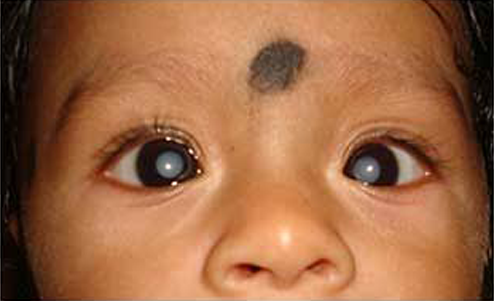Childhood Cataract
A cataract causes blurring of one’s vision. Some babies are born with cataract or develop cataract at a very early age within the first six months. This condition is called congenital or infantile cataract. In case a baby is born with a cataract it is called a congenital cataract and if a cataract develops in the first six months of life it is termed as infantile cataract.Children can have cataract in one (unilateral) or both (bilateral) their eyes. Most children with cataract in only one eye usually have good vision in the other.

There are various kinds of cataract; some impact the vision and some don’t. A cataract located towards the centre of the lens is more likely to affect vision and visual system development than the one located around the periphery of the lens. Apart from the location, the impact on the vision also depends on the size of the cataract and how dense it is.
Very dense cataracts can also cause blindness in babies if not treated.
An assessment by an ophthalmologist is essential to assess the impact of the cataract and the line of treatment.
At Birth
If the paediatric doctor suspects a child to have congenital cataract at birth, they will recommend an examination by an ophthalmologist.
It is recommended to screen the baby for any eye problem including congenital cataracts within the first 24-48 hours after birth.
Babies are normally checked again when six weeks old by a doctor. It is important to discuss your baby’s vision health with the doctor. If the doctor notices any signs of a possible eye problem or cataract he/she would refer your baby to an ophthalmologist for a full examination.
Later in Childhood
In case the cataract develops in later years and if it impacts the vision then there will be noticeable signs. For example a child may appear to have difficulty focusing on certain objects or may hold his head at a certain angle or he may develop a squint. In case you notice any such signs then you must consult an Ophthalmologist for further assessment.
Treatment
Some cataracts do not cause visual problems and surgery would not be needed. If the cataract does affect the child's vision surgery will usually be considered to remove the affected lens from the eye. Once a cataract is removed it cannot grow back. The timeframe for the surgery will be recommended by the eye surgeon based on the impact of the cataract on the vision and the development of the visual system.
During surgery
During the surgery, a small opening is made at the side of the cornea and through this the cloudy lens is removed. Once the natural lens and cataract has been removed, it will be replaced by a plastic lens called an intraocular lens or IOL. This lens implant used during surgery will last for life and usually does not need replacing. In case the child is very young then doctor may recommend using a contact lens rather than an implant. This is because it is much easier to change or remove the contact lenses since they are not implanted into the eye. In these cases an IOL is often implanted in a separate surgical procedure when a child is a bit older and his eyes are more developed.
When a baby is born, his natural eye lens is very round and more powerful than in adulthood. The power of the baby's lens and the lengthening of their eye from front to back (axial length) changes rapidly over the first few years of their life. This means that the power of an IOL used at a very young age may not be right for them as they get older, which can cause short sightedness (when distance vision is not focused properly). However, leaving a child without an eye lens (called aphakic), and using a contact lenses and/or glasses to correct vision can cause long sightedness (when near to/reading vision is not focused properly). So, the decision to use an IOL or a contact lens needs to be taken by the eye surgeon based on the child's level of vision and their age.
Ophthalmologist may also consider patching your child's stronger eye to help their brain switch onto the weaker eye. Usually you and your baby will be required to stay at the hospital for a few days so that they can make sure the baby is recovering well and show you how to take care of the baby’s eyes.

Children usually need glasses or contact lenses post cataract surgery as the artificial lens implant used to replace the natural lens has a fixed focus. This means it can't change shape like our natural eye lens to focus clearly for both near vision as well as distant vision. Glasses will ensure the vision is as clear as possible at all distances.
Children who have cataracts which don't need to be removed will also need to use glasses and contact lenses.
Some children may need a pair of glasses or contact lenses which correct their near and distant vision. They can also use bifocal glasses or lenses wherein the top section of the lens corrects distant vision and bottom part of the lens corrects near vision.


